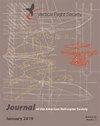雨对翼型和旋翼气动特性不利影响的数值模拟
IF 1.4
4区 工程技术
Q2 ENGINEERING, AEROSPACE
引用次数: 0
摘要
在不利的操作条件下,改善转子的性能是一个重要的兴趣。然而,对二维(2D)翼型和旋翼叶片在降雨不利影响下的性能影响的理解非常有限。此外,导致性能下降的基本物理现象还不清楚。在这项研究中,首先开发了低保真模型来快速估计二维翼型上水层的形成,并评估由此对升力和阻力特性的影响。低保真度模拟也有助于快速估计水层厚度作为液态水含量和液滴直径的函数。随后,对二维翼型和小型旋翼进行了计算流体动力学研究,以更准确地估计雨对翼型性能的影响,并在可用的情况下匹配测试数据。通过不同的迎角、雨滴中的液态水含量和水滴直径,对不同翼型进行了更高保真度的参数研究,以捕捉性能下降的趋势。所得到的趋势与测试数据的趋势相当吻合。更高保真度的翼型载荷随后在一个经典的组合叶片元素动量模型中使用,以评估小型转子的性能损失归因于雨。目前的研究表明,在推力生产的重大损失,在功率需求的上升,并在小型转子的优点数字减少,由雨引起的。本文章由计算机程序翻译,如有差异,请以英文原文为准。
Numerical Simulations of the Adverse Effects of Rain on Airfoil And Rotor Aerodynamic Characteristics
There is a significant interest in improving the performance of rotors under adverse operating conditions. However, there is a very limited understanding of the performance implications on two-dimensional (2D) airfoils and rotor blades under adverse effects of rainfall. Furthermore, the fundamental physical phenomena causing the loss in performance are not clearly understood. In this study, low-fidelity models are first developed to rapidly estimate the water layer formation on 2D airfoils and assess the resulting impact on lift and drag characteristics. The low-fidelity simulations are also useful to obtain quick estimates of water layer thickness as a function of liquid water content and droplet diameter. Subsequently, computational fluid dynamics studies for 2D airfoils and a small-scale rotor in hover are done to obtain more accurate estimates of the effects of rain on airfoil performance and match test data where available. Higher fidelity parametric studies for various airfoils were conducted by varying angles of attack, the liquid water content in the rain droplets, and the droplet diameters to capture trends in performance degradation. The resulting trends match the trends from the test data reasonably well. The higher fidelity airfoil loads are subsequently used within a classical combined blade element-momentum model to assess the loss of performance attributable to rain for a small-scale rotor. The present studies indicate a significant loss in thrust production, a rise in the power requirement, and a reduction in the figure of merit for small-scale rotors caused by rain.
求助全文
通过发布文献求助,成功后即可免费获取论文全文。
去求助
来源期刊

Journal of the American Helicopter Society
工程技术-工程:宇航
CiteScore
4.10
自引率
33.30%
发文量
36
审稿时长
>12 weeks
期刊介绍:
The Journal of the American Helicopter Society is a peer-reviewed technical journal published quarterly (January, April, July and October) by AHS — The Vertical Flight Society. It is the world''s only scientific journal dedicated to vertical flight technology and is available in print and online.
The Journal publishes original technical papers dealing with theory and practice of vertical flight. The Journal seeks to foster the exchange of significant new ideas and information about helicopters and V/STOL aircraft. The scope of the Journal covers the full range of research, analysis, design, manufacturing, test, operations, and support. A constantly growing list of specialty areas is included within that scope. These range from the classical specialties like aerodynamic, dynamics and structures to more recent priorities such as acoustics, materials and signature reduction and to operational issues such as design criteria, safety and reliability. (Note: semi- and nontechnical articles of more general interest reporting current events or experiences should be sent to the VFS magazine
 求助内容:
求助内容: 应助结果提醒方式:
应助结果提醒方式:


